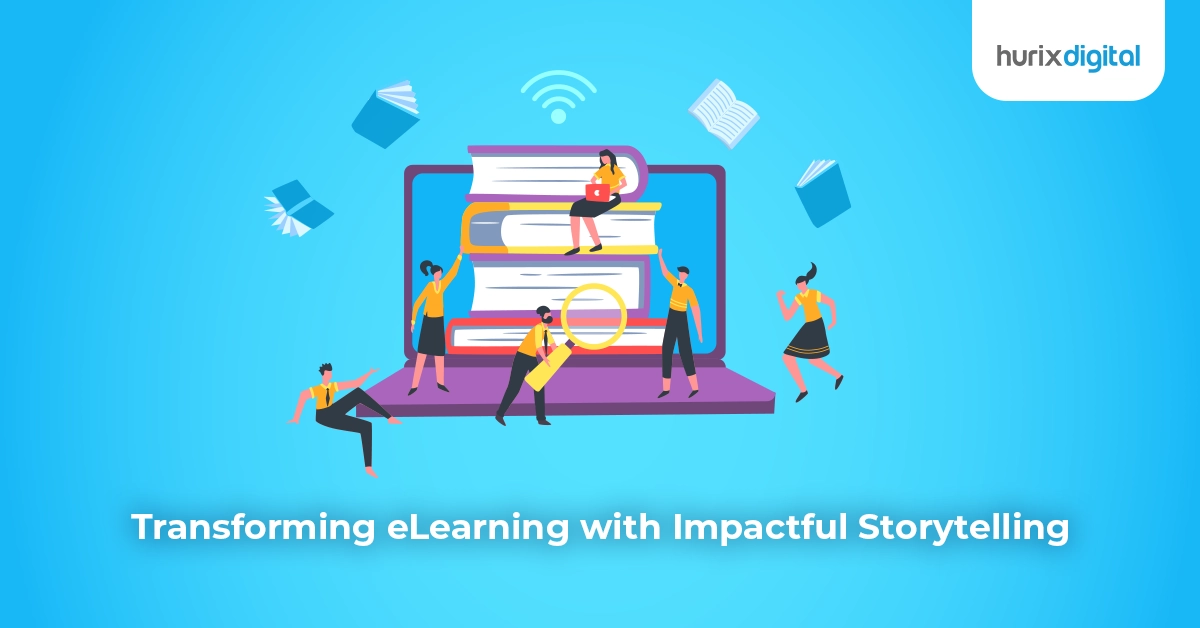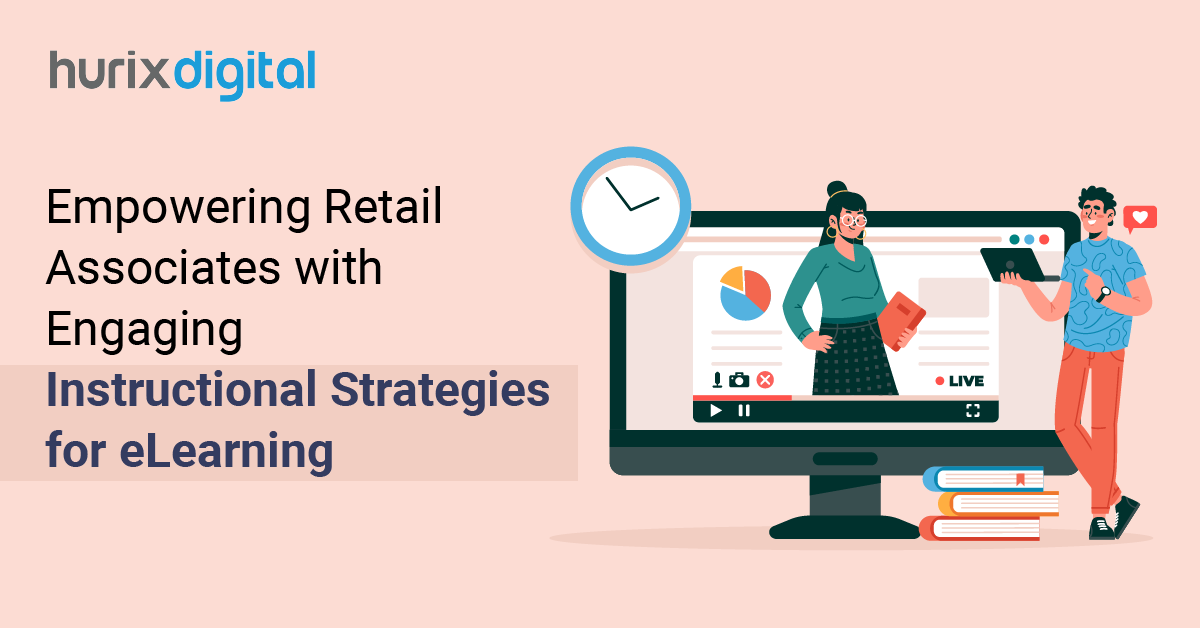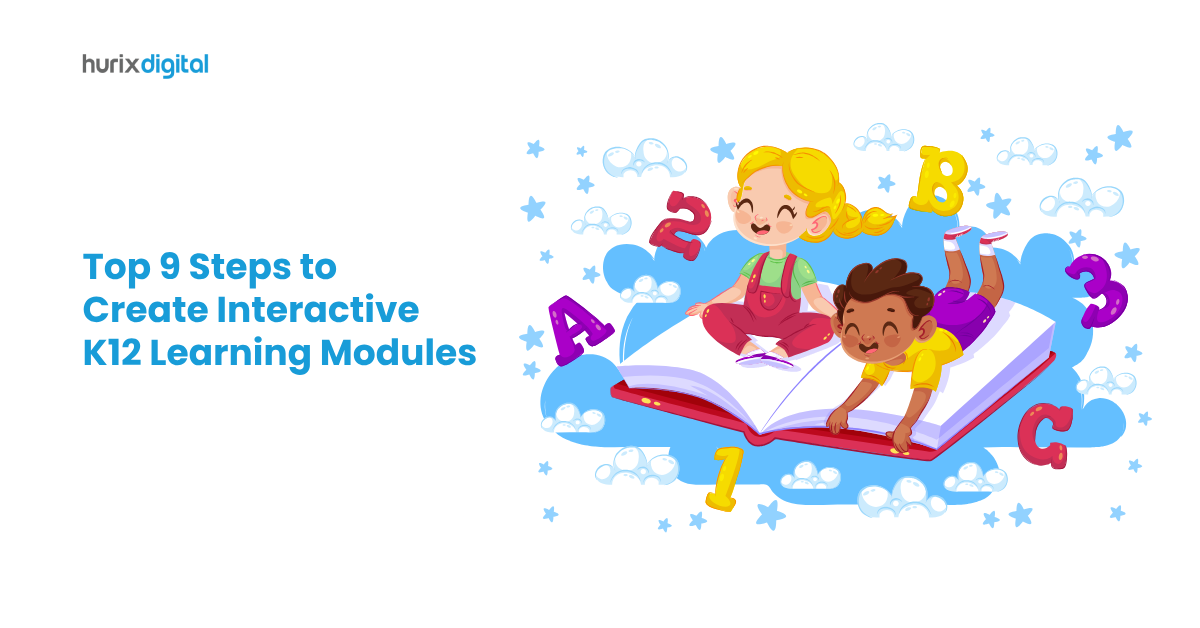
Transforming eLearning with Impactful Storytelling
Summary
This blog explores using storytelling in eLearning for increased engagement, motivation, and retention. It covers narrative elements, incorporation strategies, and tips for various eLearning formats, aiming to guide compelling narratives.
The eLearning landscape is a constantly evolving space.
With a global revenue of 166.55 billion dollars, the market is highly driven to meet learners’ latest needs. That said, many enterprise training modules are developed intensively based on facts, leading to a dry and disengaged learning experience.
Amidst the constant flux of educational exceptional and eLearning goals, deriving tangible results lies in the power of a learning module’s ability to engage and promote retention.
One element that towers over most in this aspect is storytelling. Studies show that storytelling can boost one’s ability to recall learning from 10% to a staggering 70%. With how impactful a compelling narrative can be, incorporating it in every business’ workforce learning structure becomes imperative.
To equip you with a thorough understanding, this article will cover how storytellers affect eLearning and key strategies that effectively boost the quality of eLearning solutions. Read on!
Table of Contents:
- Why Storytelling Works in eLearning
- Elements of Effective eLearning Narratives
- Storytelling Strategies and Practices for Effective Elearning
- Storytelling Tips and Techniques for Different eLearning Formats
- Steering the eLearning Narrative
Why Storytelling Works in eLearning
From ancient parables with morales to modern-day case studies with concrete data-driven insights, the core of learning has always been in the stories woven around it.
In the world of eLearning, storytelling has transcended being an engaging tactic. As a powerful tool that steers our brain’s function and recall ability, storytelling sparks an innate drive to find meaning.
Here are some key reasons why storytelling impacts eLearning.
1. The Science of Stories
Studies have shown that storytelling in a learning module has a neurological impact on learners. Learning through storytelling facilitates a higher quality of recall, engagement, and reliability because of a combination of these chemicals that are released,
- Cortisol released while listening to a narrative keeps you attentive and aware.
- Dopamine that links with pleasure and boosts engagement levels.
- Oxytocin, when released, allows the learner to relate to eLearning content and characters. This creates a sense of connection and empathy, making the information more memorable and relatable.
2. Emotional Connection
In addition to the chemical oxytocin, which fosters reliability, stories evoke emotions. This is the key to delivering relatable learning modules. With a compelling narrative, a client case study transforms dry concepts into practical knowledge.
3. Motivation and Meaning
To put content into practical use, a learner needs purpose and motivation. Stories provide context to a complex topic, making it much easier to link the learnings when confronted with real-world scenarios. It also provides insight into the consequences of tasks, such as disregarding and inserting a compelling story around safety protocols to make the information impactful.
Elements of Effective eLearning Narratives
Now that we understand storytelling’s scientific impact and role in eLearning modules, here are the essential elements that make for compelling eLearning narratives.
1. Relatable Characters
It is fundamental to have relatable characters in every learning module. This allows the learners to see themselves in the learning experience, no matter how new the subject is.
For the best impact, these characters need to feel authentic. This helps to establish a connection with the audience and makes the learning journey more personal and relevant.
2. Confronting Challenges
A straightforward narrative that involves no problem or issue often loses learners because it is predictable and fails to highlight the skill’s impact. Weaving challenges and problem statements into the training content is a pillar of compelling eLearning narratives.
Challenges, obstacles, and even occasional failures reflect real-world work dynamics within workforce learning. It also drives the learner to develop more meaningful resolutions.
3. Plot Structure
The final element of storytelling in eLearning modules is plot structure. A simple narrative structure such as problem, struggle, and resolution helps keep learners focused on the objective or target skill.
With the key elements in mind, let’s equip you with strategies to help you build effective narratives.
Also Read: Unlocking the Potential: How SCORM Integration Enhances eLearning Platforms?
Storytelling Strategies and Practices for Effective eLearning
A story is a compelling tool on its own, but enterprise learning modules need to be structured to focus on delivering measurable outcomes. Here are four key strategies that will do just that and more.
1. Module Around Learning Objectives
A compelling narrative is vital, but ensure that your learning content is designed around training goals from inception. Actively craft the story to align directly with the skills the learner must develop or key takeaways that are most crucial to retain.
2. Scenario-Based Learning with Immersive Technologies
Immersive technologies like Virtual Reality (VR) and online simulations are taking the education market by storm. With their impact on engagement levels soaring, VR in education was valued at 4.4 billion dollars as of 2023 and will only rise.
Virtual reality is a technology that immerses a learner in a digital environment through multisensory equipment, such as goggles and headgear.
Scenario-based learning delivers powerful and relatable content by presenting situations that a learner may encounter or even exercises that incorporate real-world parameters. Combining this with VR allows learners to react in simulations and review the consequences of their actions, too.
3. Branching Narratives
Allow learners to make decisions at key narrative points. Deploying an interactive narrative is a critical strategy that builds decision-making skills and delivers a personalized experience for the learner.
With each decision impacting the story’s progression, learners are more invested in understanding the reasons behind each choice. This plays a massive role in active learning and faster growth rates.
4. Gamification
This modern-age learning approach has proven to boost motivation and engagement by up to 48%. Gamification incorporates gaming elements like gaming levels, points and badges, instant feedback, and even personalized elements like avatars.
Gamification fosters healthy competition, rewards, and recognition, which makes it a perfect fit for a narrative-driven learning approach. This strategy delivers vital advantages by elevating the overall learning impact and is also highly compatible with adaptative learning modules.
While these strategies and practices are explained individually, infusing the right mix of all four will undoubtedly transform the learning module.
Storytelling Tips and Techniques for Different eLearning Formats
Learning content can be delivered in several innovative formats, from videos to simulations. Understanding how to produce a compelling narrative in each form can boost learning outcomes and completion times.
Here are some quick techniques and pointers to keep in mind when adopting a narrative approach in these learning formats,
1. Microlearning
Microlearning is a short and crisp learning approach that delivers content ranging from 3 to 5 minutes in length targeted for a specific objective or skill. Avoid complex plots or character development that could overwhelm the short format. This way, learners can quickly grasp key concepts without feeling overloaded.
2. Video-Based Learning
With the option of elements other than words, strong characterization, and visuals are essential to bringing the narrative to life. A straightforward plot structure and relatable characters are vital for narratives to create impact in this format.
3. Simulations
Technologies like VR and online web simulations should focus strongly on learning objectives and plot structure. This is because simulations often involve learners, making reliability easier.
4. Mobile Learning
In this learning format, content that is easy to comprehend is key. With mobile devices’ screens and loading platforms in mind, a narrative is best delivered through quick text-based stories or interactive comics optimized for mobile consumption.
Also Read: A Complete Guide on eLearning Localization to Enhance Your Global Training Programs
Steering the eLearning Narrative
Storytelling can make even the most technical content appealing and engaging. In workforce learning, this becomes crucial when designing modules that derive tangible results and an expanded knowledge base.
While the strategies and tips we’ve covered in this article are guaranteed to elevate the quality of your training modules, a comprehensive learning solution with a compelling narrative is often a resource-consuming affair best executed by experts.
Our team at Hurix Digital is seasoned in crafting eLearning solutions tailored to your business needs. We understand the science behind effective storytelling and possess the creative expertise to transform complex concepts into captivating narratives that drive learning outcomes.
Contact us now, and let’s steer the eLearning narrative together!

A highly enthusiastic and motivated sales professional with over twenty five years of experience in solution selling of training-related applications and services. Maintains an assertive and dynamic style that generates results. Ability to establish long-term relationships with clients built on trust, quality of service and strategic vision. Specializes in financial services, higher ed, publishing and government in the areas of learning and development.








